1967 CHEVROLET CAMARO check engine
[x] Cancel search: check enginePage 318 of 659

ENGINE FUEL
6M-10
the
two
"FILL71 lines
(fig.
6A). Refill whenever
the
level
falls below the lower
<'FILL"
line.
Storing Tool
When
the
tool
is
not used, fully depress
the
inner tube.
This seals
off
the
oil
reservoir from the vent hole
to pre-
vent
oil
loss
if
the tool
is
tipped.
Fig. 6A-Filling Tool with
Oil
FUEL PUMP
INDEX
Page
General Description
. . . . 6M-10
Service Procedures .6M-10
Inspection .6M-10
Page
Test
. . ; 6M-10
Removal
6M-11
Installation
6M-11
GENERAL DESCRIPTION
The fuel pump
(fig. IP)
used
on all
Chevrolet vehicles
covered
in
this manual
are of the
diaphragm type.
The
pumps
are
actuated
by an
eccentric located on
the
engine
camshaft.
On
in-line engines,
the
eccentric actuates
the
rocker arm*
On V-8
engines,
a
push
rod
(located be-
tween
the
camshaft eccentric and fuel pump) actuates
the
pump rocker
arm.
Because
of
design, this pump
is
serviced
as an
assembly only.
Fig.
IP—Fuel Pump (Non-Serviceable)
SERVICE PROCEDURES
Inspection
The fuel pump should
be
checked
to
make sure
the
mounting bolts
and
inlet and outlet connections
are
tight.
Test
Always test pump while
it is
mounted on the engine
and
be sure there
is
gasoline
in
the tank.
The line from
the
tank
to the
pump
is the
suction side
of
the
system and the line from the pump
to the
carbure-
tor
is the
pressure side
of the
system.
A
leak on
the
pressure side, therefore, would
be
made apparent
by
CHEVROLET CHASSIS SERVICE MANUAL
Page 319 of 659

ENGINE FUEL 6M-11
dripping fuel, but a leak on the suction would not be ap-
parent except for its effect of reducing volume of fuel on
the pressure side.
1.
Tighten any loose line connections and look for bends
or kinks in lines.
2.
Disconnect fuel pipe at carburetor. Disconnect dis-
tributor to coil primary wire so that engine can be
cranked without firing. Place suitable container at
end of pipe and crank engine a few revolutions. If
little or no gasoline flows from open end of pipe then
fuel pipe is clogged or pump is inoperative. Before
removing pump disconnect fuel pipe at gas tank and
outlet pipe and blow through them with an air hose
to make sure they are clear. Reconnect pipes and
retest while cranking engine.
CAUTION: Whenever the engine is cranked re-
motely at the starter, with a special jumper
cable or other means, the primary distributor
lead must be disconnected from the negative
post on the coil and the ignition switch must be
in the "ON" position. Failure to do this will
result in a damaged grounding circuit in the
ignition switch.
3.
If fuel flows from pump in good volume from pipe
at carburetor, check fuel delivery pressure to be
certain that pump is operating withint specified limits
as follows:
a. Attach a fuel pump pressure test gauge to dis-
connect end of pump to carburetor pipe.
b.
Run engine at approximately 450-1,000 rpm (on
gasoline in carburetor bowl) and note reading on
pressure gauge.
c. If pump is operating properly the pressure will
be within specifications and will remain constant
at speeds between 450-1,000 rpm. If pressure
is too low, too high, or varies materially at dif-
ferent speeds, the pump should be replaced.
Removal
1.
Disconnect fuel inlet and outlet pipes at fuel pump.
Fig.
2P-Installing 283, 327, 350 V8 Engine Fuel Pump
2.
Remove fuel pump mounting bolts and remove pump
and gasket.
3.
On V8 engines; if push rod is to be removed, remove
pipe plug then remove push rod (396 and 427 cu. in.
engines), remove fuel pump adapter and gasket then
remove push rod (283 and 327 cu. in. engines).
4.
If a new fuel pump is to be installed, transfer
fittings.
Installation
1.
On V8 engines; if removed, install fuel pump push
rod and pipe fitting or fuel pump adapter. Use.
gasket sealer on gasket or pipe fitting.
2.
Install fuel pump using a new gasket and tighten
securely. Use sealer on fuel pump mounting bolt
threads.
NOTE:
On V8 engines, a pair of mechanical
fingers may be used to hold fuel pump push rod
up while installing fuel pump (fig. 2P).
3.
Connect fuel pipes to pump.
4.
Start engine and check for leaks.
CHEVROLET CHASSIS SERVICE MANUAL
Page 321 of 659
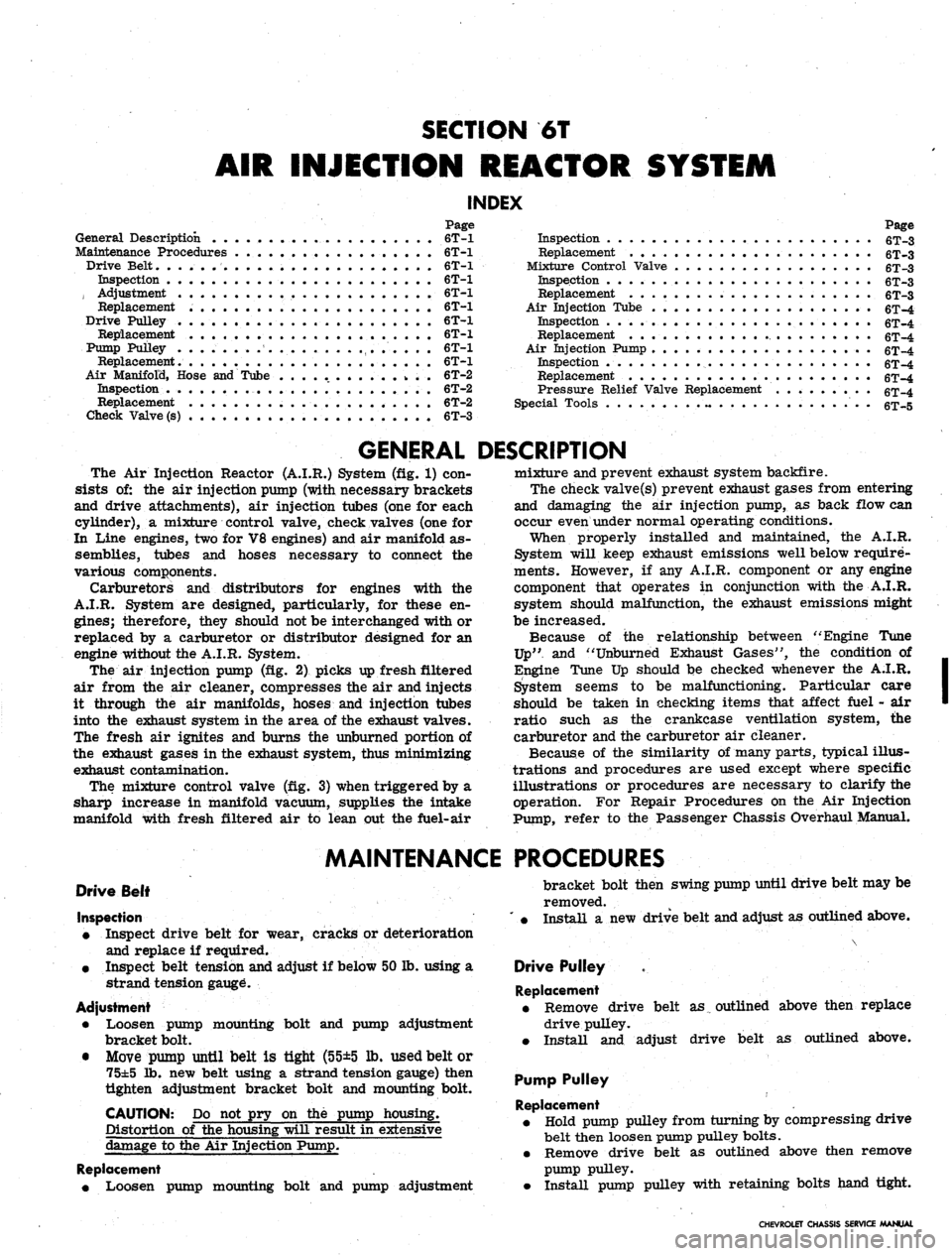
SECTION 6T
AIR INJECTION REACTOR SYSTEM
INDEX
Page
General Description 6T-1
Maintenance Procedures 6T>1
Drive Belt. ...-..' 6T-1
Inspection 6T-1
, Adjustment . . 6T-1
Replacement 6T-1
Drive Pulley . . . . 6T-1
Replacement 6T-1
Pump Pulley ....................... 6T-1
Replacement. 6T-1
Air Manifold, Hose and Tube
...........>*.
6T-2
Inspection . . 6T-2
Replacement 6T-2
Check Valve (s) 6T-3
Page
Inspection 6T-3
Replacement . . 6T-3
Mixture Control Valve 6T-3
Inspection 6T-3
Replacement 6T-3
Air Injection Tube 6T-4
Inspection . . . ... . . . .... 6T-4
Replacement 6T-4
Air Injection Pump 6T-4
Inspection 6T-4
Replacement . 6T-4
Pressure Relief Valve Replacement 6T-4
Special Tools 6T-5
GENERAL
The Air Injection Reactor (A.I.R.) System (fig. 1) con-
sists of: the air injection pump (with necessary brackets
and drive attachments), air injection tubes (one for each
cylinder), a mixture control valve, check valves (one for
In Line engines, two for V8 engines) and air manifold as-
semblies, tubes and hoses necessary to connect the
various components.
Carburetors and distributors for engines with the
A.I.R. System are designed, particularly, for these en-
gines;
therefore, they should not be interchanged with or
replaced by a carburetor or distributor designed for an
engine without the A.I.R. System.
The air injection pump (fig. 2) picks up fresh filtered
air from the air cleaner, compresses the air and injects
it through the air manifolds, hoses and injection tubes
into the exhaust system in the area of the exhaust valves.
The fresh air ignites and burns the unburned portion of
the exhaust gases in the exhaust system, thus minimizing
exhaust contamination.
The mixture control valve (fig. 3) when triggered by a
sharp increase in manifold vacuum, supplies the intake
manifold with fresh filtered air to lean out the fuel-air
DESCRIPTION
mixture and prevent exhaust system backfire.
The check valve(s) prevent exhaust gases from entering
and damaging the air injection pump, as back flow can
occur even under normal operating conditions.
When properly installed and maintained, the A.I.R.
System will keep exhaust emissions well below require-
ments. However, if any A.I.R. component or any engine
component that operates in conjunction with the A.I.R.
system should malfunction, the exhaust emissions might
be increased.
Because of the relationship between "Engine Tune
Up"
and "Unburned Exhaust Gases", the condition of
Engine Tune Up should be checked whenever the A.I.R.
System seems to be malfunctioning. Particular care
should be taken in checking items that affect fuel - air
ratio such as the crankcase ventilation system, the
carburetor and the carburetor air cleaner.
Because of the similarity of many parts, typical illus-
trations and procedures are used except where specific
illustrations or procedures are necessary to clarify the
operation. For Repair Procedures on the Air Injection
Pump,
refer to the Passenger Chassis Overhaul Manual.
MAINTENANCE PROCEDURES
Drive Belt
Inspection
• Inspect drive belt for wear, cracks or deterioration
and replace if required.
• Inspect belt tension and adjust if below 50 lb. using a
strand tension gauge.
Adjustment
• Loosen pump mounting bolt and pump adjustment
bracket bolt.
• Move pump until belt is tight (55±5 lb. used belt or
75±5 lb. new belt using a strand tension gauge) then
tighten adjustment bracket bolt and mounting bolt.
CAUTION: Do not pry on the pump housing.
Distortion of the housing will result in extensive
damage to the Air Injection Pump.
Replacement
• Loosen pump mounting bolt and pump adjustment
bracket bolt then swing pump until drive belt may be
removed.
• Install a new drive belt and adjust as outlined above.
Drive Pulley .
Replacement
• Remove drive belt as outlined above then replace
drive pulley.
• Install and adjust drive belt as outlined above.
Pump Pulley
Replacement
• Hold pump pulley from turning by compressing drive
belt then loosen pump pulley bolts.
• Remove drive belt as outlined above then remove
pump pulley.
• Install pump pulley with retaining bolts hand tight.
CHEVROLET CHASSIS SERVICE MANUAL
Page 323 of 659
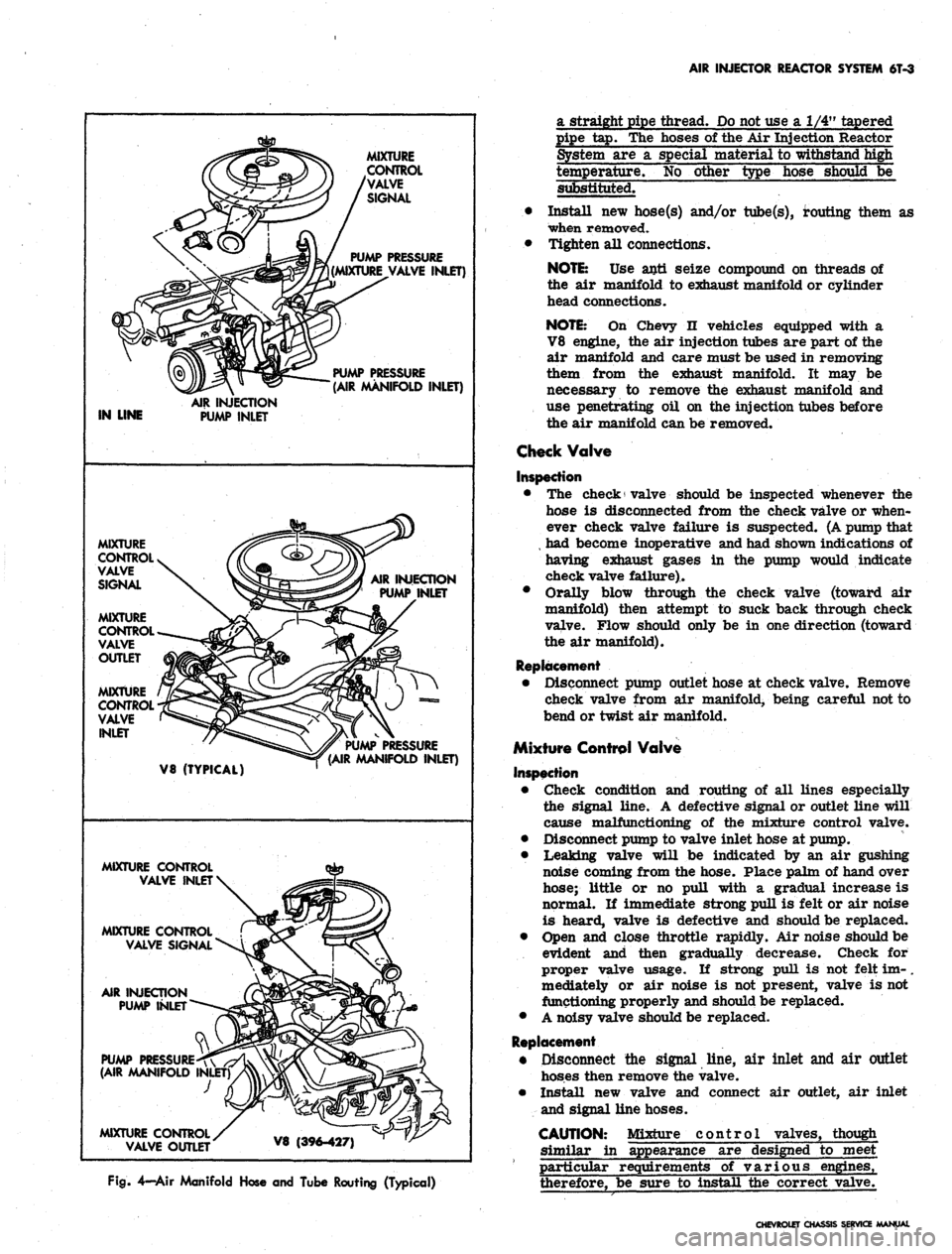
AIR INJECTOR REACTOR SYSTEM
6T-3
MIXTURE
CONTROL
VALVE
SIGNAL
PUMP PRESSURE
(MIXTURE VALVE INLET)
PUMP PRESSURE
(AIR MANIFOLD INLET)
IN LINE
AIR INJECTION
PUMP INLET
MIXTURE
CONTROL
VALVE
SIGNAL
MIXTURE
CONTROL
VALVE
OUTLET
MIXTURE
CONTROL
VALVE
INLET
AIR INJECTION
PUMP INLET
V8 (TYPICAL)
PUMP PRESSURE
(AIR MANIFOLD INLET)
MIXTURE CONTROL
VALVE INLET
MIXTURE CONTROL
VALVE SIGNAL
AIR INJECTION
PUMP INLET
PUMP PRESSURE^
(AIR MANIFOLD
J
MIXTURE CONTROL
VALVE OUTLET
V8 (396-427)
Fig.
4—Air Manifold Hose and Tube Routing (Typical)
a straight pipe thread.
Do
not use
a 1/4"
tapered
pipe
tap. The
hoses
of
the
Air
Injection Reactor
System
are a
special material
to
withstand high
temperature.
No
other type hose should
be
substituted.
• Install
new
hose(s) and/or tube(s), routing them
as
when removed.
• Tighten
all
connections.
NOTE:
Use
anti seize compound
on
threads
of
the
air
manifold
to
exhaust manifold
or
cylinder
head connections.
NOTE:
On
Chevy
n
vehicles equipped with
a
V8 engine,
the air
injection tubes
are
part
of the
air manifold
and
care must
be
used
in
removing
them from
the
exhaust manifold.
It may be
necessary
to
remove
the
exhaust manifold
and
use penetrating
oil on the
injection tubes before
the
air
manifold can
be
removed.
Check Valve
Inspection
•
The
check valve should
be
inspected whenever
the
hose
is
disconnected from
the
check valve
or
when-
ever check valve failure
is
suspected. (A pump that
,
had
become inoperative and had shown indications
of
having exhaust gases
in the
pump would indicate
check valve failure)..
• Orally blow through
the
check valve (toward
air
manifold) then attempt
to
suck back through check
valve. Flow should only
be in one
direction (toward
the
air
manifold).
Replacement
• Disconnect pump outlet hose
at
check valve. Remove
check valve from
air
manifold, being careful not
to
bend
or
twist
air
manifold.
Mixture Control Valve
Inspection
• Check condition
and
routing
of all
lines especially
the signal line.
A
defective signal
or
outlet line will
cause malfunctioning
of the
mixture control valve.
• Disconnect pump
to
valve inlet hose
at
pump.
• Leaking valve will
be
indicated
by an air
gushing
noise coming from
the
hose. Place palm
of
hand over
hose; little
or no
pull with
a
gradual increase
is
normal.
If
immediate strong pull
is
felt
or air
noise
is heard, valve
is
defective
and
should
be
replaced.
• Open
and
close throttle rapidly.
Air
noise should
be
evident
and
then gradually decrease. Check
for
proper valve usage.
If
strong pull
is not
felt
im-.
mediately
or air
noise
is not
present, valve
is not
functioning properly and should be replaced.
•
A
noisy valve should be replaced.
Replacement
• Disconnect
the
signal line,
air
inlet
and air
outlet
hoses then remove
the
valve.
• Install
new
valve
and
connect
air
outlet,
air
inlet
and signal line hoses.
CAUTION: Mixture control valves, though
similar
in
appearance
are
designed
to
meet
particular requirements
of
various engines,
therefore,
be
sure
to
install
the
correct valve.
CHEVROLET CHASSIS SERVICE MANUAL
Page 324 of 659
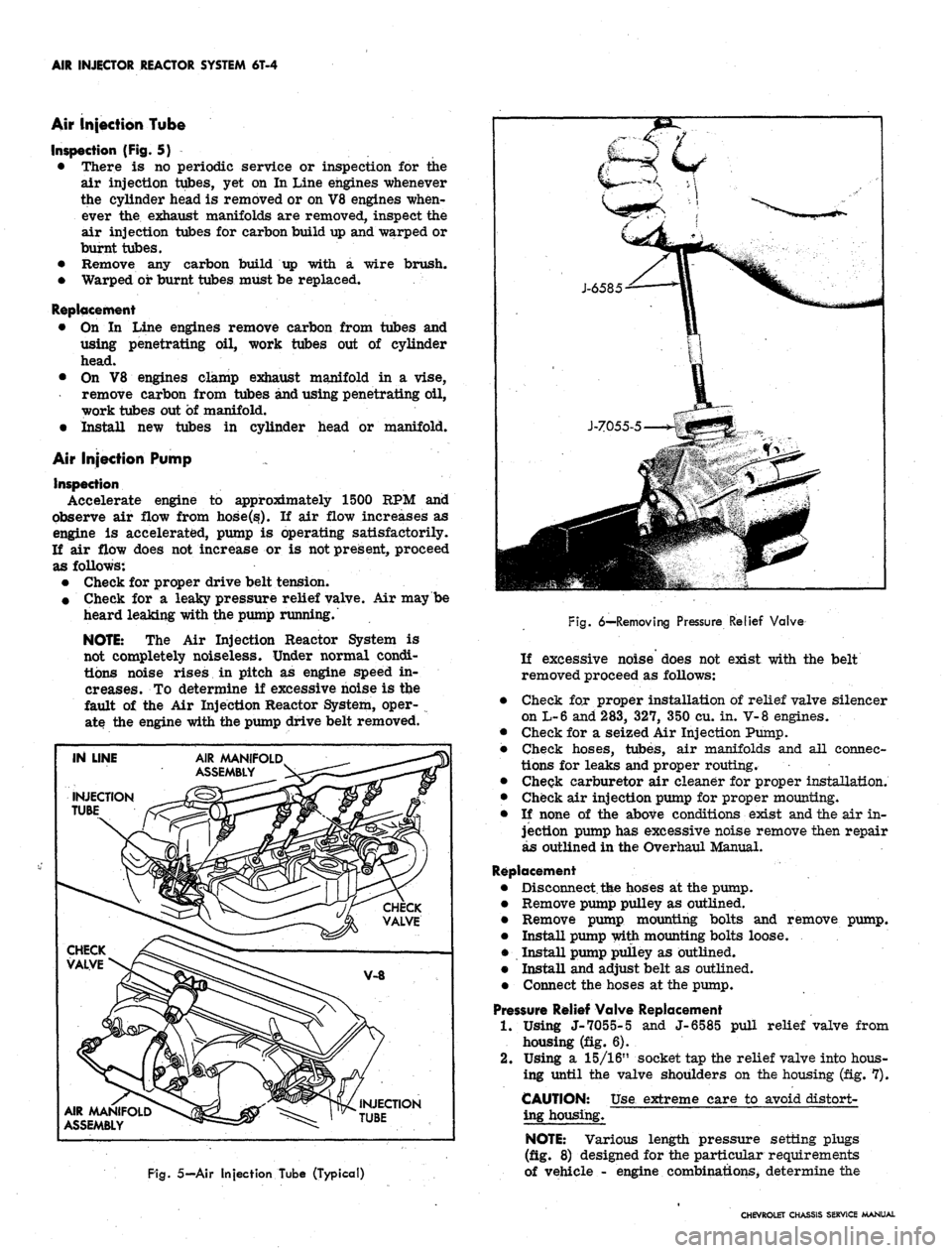
AIR INJECTOR REACTOR SYSTEM 6T-4
Air injection Tube
Inspection (Fig. 5)
• There is no periodic service or inspection for the
air injection tubes, yet on In Line engines whenever
the cylinder head is removed or on V8 engines when-
ever the exhaust manifolds are removed, inspect the
air injection tubes for carbon build up and warped or
burnt tubes.
• Remove any carbon build up with a wire brush.
• Warped or burnt tubes must be replaced.
Replacement
• On In Line engines remove carbon from tubes and
using penetrating oil, work tubes out of cylinder
head.
• On V8 engines clamp exhaust manifold in a vise,
remove carbon from tubes and using penetrating oil,
work tubes out of manifold.
• Install new tubes in cylinder head or manifold.
Air Injection Pump
Inspection
Accelerate engine to approximately 1500 KPM and
observe air flow from hose.Osf). If air flow increases as
engine is accelerated, pump is operating satisfactorily.
If air flow does not increase or is not present, proceed
as follows:
• Check for proper drive belt tension.
• Check for a leaky pressure relief valve. Air maybe
heard leaking with the pump running.
NOTE:
The Air Injection Reactor System is
not completely noiseless. Under normal condi-
tions noise rises in pitch as engine speed in-
creases. To determine if excessive noise is the
fault of the Air Injection Reactor System, oper-
ate the engine with the pump drive belt removed.
IN LINE
INJECTION
si
AIR AAANIFOLD^
ASSEMBLY
AIR MANIFOLD
ASSEMBLY ^S
~jk
VALVE
V-8
ff
>yi
INJECTION
» TUBE
' ,•
Fig.
5—Air Injection Tube (Typical)
Fig.
6-HRemoving Pressure Relief Valve
If excessive noise does not exist with the belt
removed proceed as follows:
Check for proper installation of relief valve silencer
on L-6 and 283, 327, 350 cu. in. V-8 engines.
Check for a seized Air Injection Pump.
Check hoses, tubes, air manifolds and all connec-
tions for leaks and proper routing.
Cheqk carburetor air cleaner for proper installation.
Check air injection pump for proper mounting.
If none of the above conditions exist and the air in-
jection pump has excessive noise remove then repair
as outlined in the Overhaul Manual.
Replacement
Disconnect,
t&e
hoses at the pump.
Remove pump pulley as outlined.
Remove pump mounting bolts and remove pump.
Install pump with mounting bolts loose.
Install pump pulley as outlined.
Install and adjust belt as outlined.
Connect the hoses at the pump.
Pressure Relief Valve Replacement
1.
Using J-7055-5 and J-6585 pull relief valve from
housing (fig. 6).
2.
Using a 15/16" socket tap the relief valve into hous-
ing until the valve shoulders on the housing (fig. 7).
CAUTION: Use extreme care to avoid distort-
ing housing.
NOTE:
Various length pressure setting plugs
(fig. 8) designed for the particular requirements
of vehicle - engine combinations, determine the
CHEVROLET CHASSIS SERVICE MANUAL
Page 327 of 659
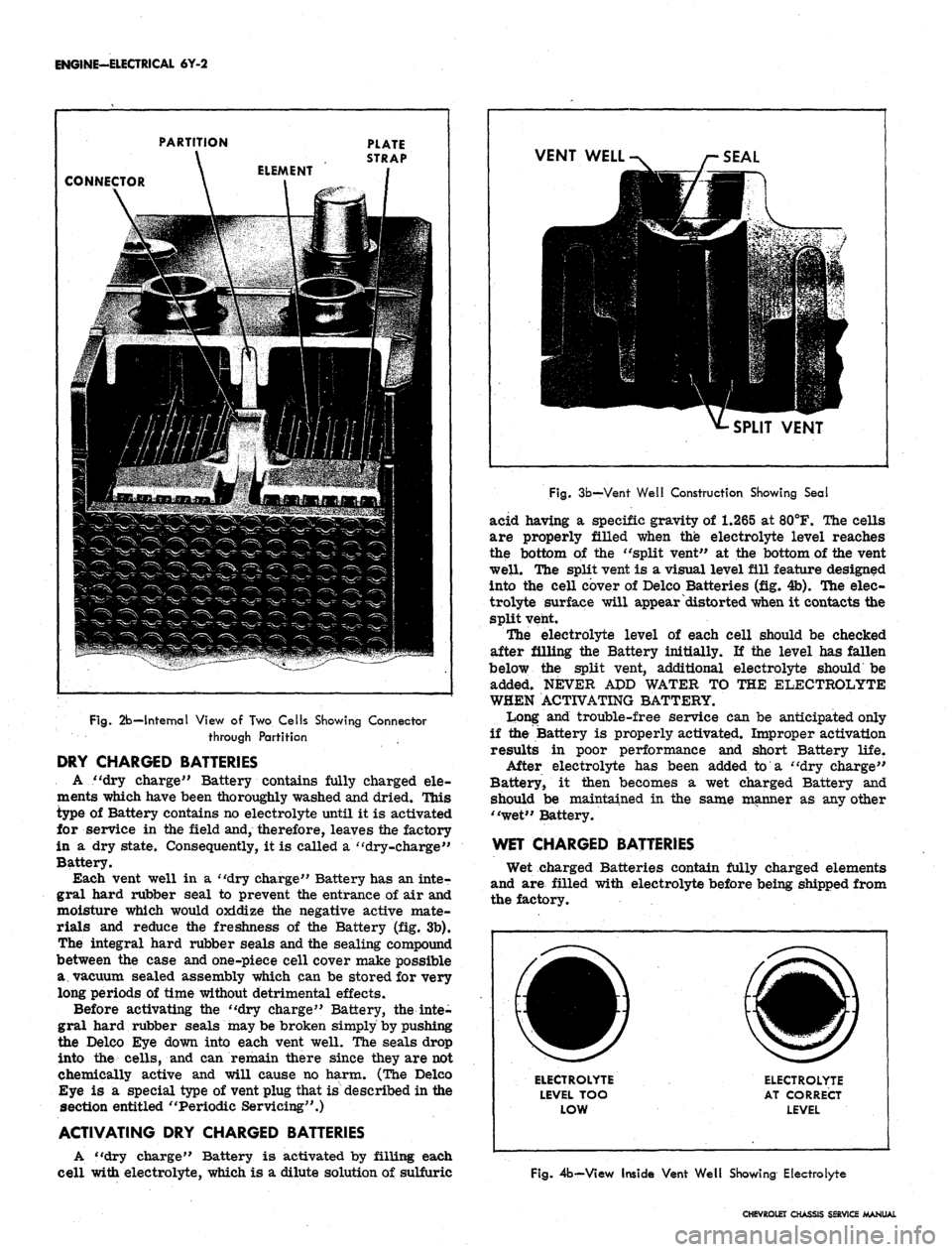
ENGINE-ELECTRICAL 6Y-2
PARTITION
PLATE
STRAP
CONNECTOR
Fig.
2b—Internal View of Two Cells Showing Connector
through Partition
DRY CHARGED BATTERIES
A "dry charge" Battery contains fully charged ele-
ments which have been thoroughly washed and dried. Hiis
type of Battery contains no electrolyte until it is activated
for service in the field and, therefore, leaves the factory
in a dry state. Consequently, it is called a "dry-charge"
Battery.
Each vent well in a "dry charge" Battery has an inte-
gral hard rubber seal to prevent the entrance of air and
moisture which would oxidize the negative active mate-
rials and reduce the freshness of the Battery (fig. 3b).
The integral hard rubber seals and the sealing compound
between the case and one-piece cell cover make possible
a. vacuum sealed assembly which can be stored for very
long periods of time without detrimental effects.
Before activating the "dry charge" Battery, the inte-
gral hard rubber seals may be broken simply by pushing
the Delco Eye down into each vent well. The seals drop
into the cells, and can remain there since they are not
chemically active and will cause no harm. (The Delco
Eye is a special type of vent plug that is described in the
section entitled "Periodic Servicing".)
ACTIVATING DRY CHARGED BATTERIES
A "dry charge" Battery is activated by filling each
cell with electrolyte, which is a dilute solution of sulfuric
VENT WELL
SEAL
SPLIT VENT
Fig. 3b—Vent Well Construction Showing Seal
acid having a specific gravity of 1.265 at 80°F. The cells
are properly filled when the electrolyte level reaches
the bottom of the "split vent" at the bottom of the vent
well. The split vent is a visual level fill feature designed
into the cell cover of Delco Batteries (fig. 4b). The elec-
trolyte surface will appear distorted when it contacts the
split vent.
The electrolyte level of each cell should be checked
after filling the Battery initially. If the level has fallen
below the split vent, additional electrolyte should be
added. NEVER APD WATER TO THE ELECTROLYTE
WHEN ACTIVATING BATTERY.
Ir?ong and trouble-free service can be anticipated only
if the Battery is properly activated. Improper activation
results in poor performance and short Battery life.
After electrolyte has been added to a "dry charge"
Battery, it then becomes a wet charged Battery and
should be maintained in the same manner as any other
"wet" Battery.
WET CHARGED BATTERIES
Wet charged Batteries contain fully charged elements
and are filled with electrolyte before being shipped from
the factory.
ELECTROLYTE
LEVEL TOO
LOW
ELECTROLYTE
AT CORRECT
LEVEL
Fig. 4b-View Inside Vent Well Showing Electrolyte
CHEVROLET CHASSIS SERVICE MANUAL
Page 328 of 659
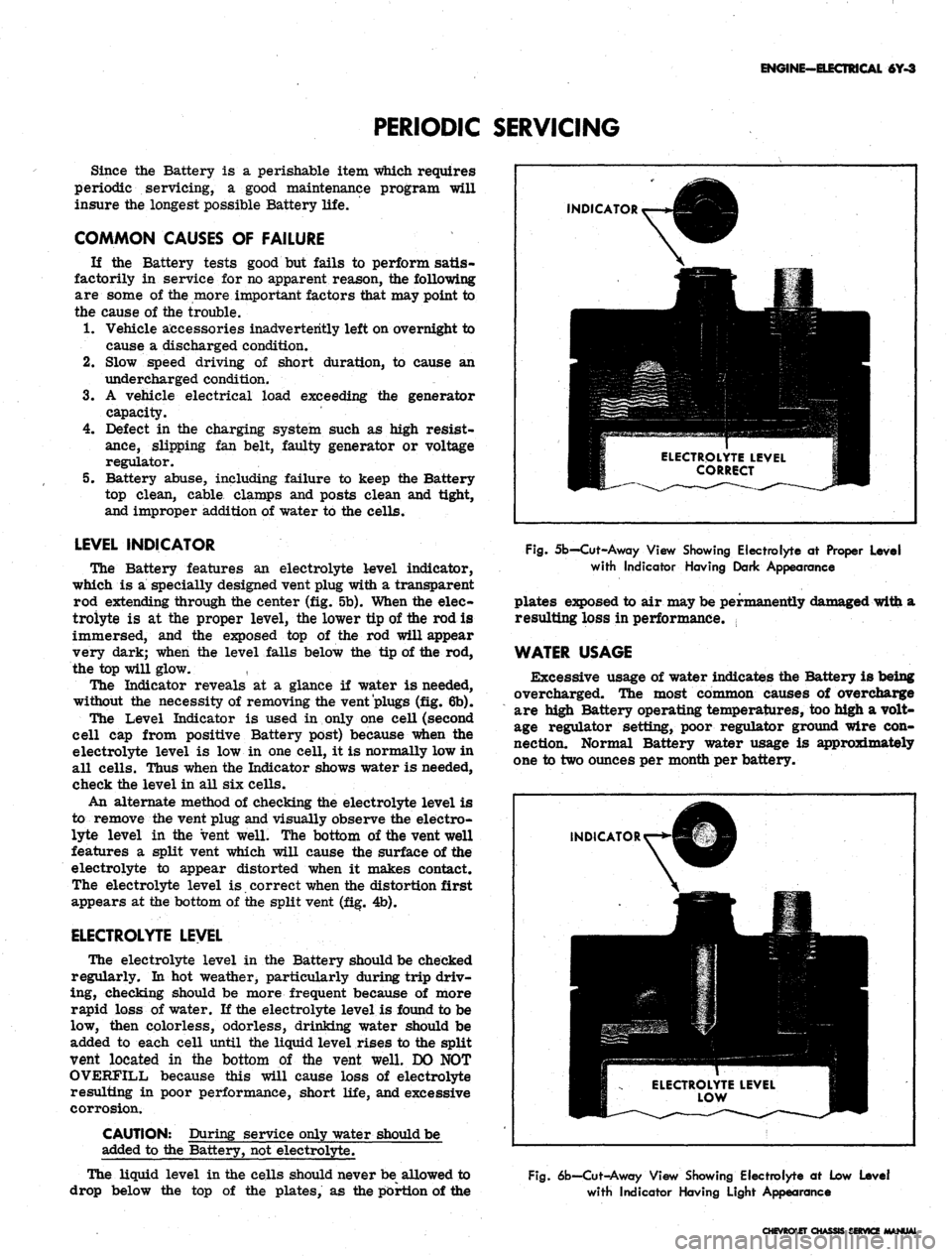
ENGINE-EIECTRICAI 6Y-3
PERIODIC SERVICING
Since the Battery is a perishable item which requires
periodic servicing, a good maintenance program will
insure the longest possible Battery life.
COMMON CAUSES OF FAILURE
If the Battery tests good but fails to perform satis-
factorily in service for no apparent reason, the following
are some of the more important factors that may point to
the cause of the trouble.
1.
Vehicle accessories inadvertently left on overnight to
cause a discharged condition.
2.
Slow speed driving of short duration, to cause an
3.
undercharged condition.
A vehicle
capacity.
electrical load exceeding the generator
4.
Defect in the charging system such as high resist-
ance, slipping fan belt, faulty generator or voltage
regulator.
5. Battery abuse, including failure to keep the Battery
top clean, cable clamps and posts clean and tight,
and improper addition of water to the cells.
LEVEL INDICATOR
The Battery features an electrolyte level indicator,
which is a specially designed vent plug with a transparent
rod extending through the center (fig. 5b). When the elec-
trolyte is at the proper level, the lower tip of the rod is
immersed, and the exposed top of the rod will appear
very dark; when the level falls below the tip of the rod,
the top will glow. ,
The Indicator reveals at a glance if water is needed,
without the necessity of removing the vent plugs (fig. 6b).
The Level Indicator is used in only one cell (second
cell cap from positive Battery post) because when the
electrolyte level is low in one cell, it is normally low in
all cells. Thus when the Indicator shows water is needed,
check the level in all six cells.
An alternate method of checking the electrolyte level is
to remove the vent plug and visually observe the electro-
lyte level in the vent well. The bottom of the vent well
features a split vent which will cause the surface of the
electrolyte to appear distorted when it makes contact.
The electrolyte level is. correct when the distortion first
appears at the bottom of the split vent (fig. 4b).
ELECTROLYTE LEVEL
The electrolyte level in the Battery should be checked
regularly. In hot weather, particularly during trip driv-
ing, checking should be more frequent because of more
rapid loss of water. If the electrolyte level is found to be
low, then colorless, odorless, drinking water should be
added to each cell until the liquid level rises to the split
vent located in the bottom of the vent well. DO NOT
OVERFILL because this will cause loss of electrolyte
resulting in poor performance, short life, and excessive
corrosion.
CAUTION: During service only water should be
added to the Battery, not electrolyte.
The liquid level in the cells should never be allowed to
drop below the top of the plates, as the portion of the
INDICATOR
ELECTROLYTE LEVEL
CORRECT
Fig.
5b—Cut-Away View Showing Electrolyte at Proper Level
with Indicator Having Dark Appearance
plates exposed to air may be permanently damaged with a
resulting loss in performance.
WATER USAGE
Excessive usage of water indicates the Battery is being
overcharged. The most common causes of overcharge
are high Battery operating temperatures, too high a volt-
age regulator setting, poor regulator ground wire con-
nection. Normal Battery water usage is approximately
one to two ounces per month per battery.
INDICATOR
Fig.
6b—Cut-Away View Showing Electrolyte at Low Level
with Indicator Having Light Appearance
CHASSIS SBtVKZ MANUAL
Page 329 of 659

ENGINE-ELECTRICAL
6Y-4
CLEANING
The external condition of the Battery should be checked
periodically for damage or for the presence of dirt and
corrosion. The top of the Battery should be kept clean.
An accumulation of acid film and dirt may permit current
to flow between the terminals, which will slowly dis-
charge the Battery. For best results when cleaning the
top of Batteries, wash first with a diluted ammonia or a
soda solution to neutralize any acid present; then flush
with clean water. Care must be taken to keep vent plugs
tight, so that the neutralizing solution does not enter the
cells.
CABLES
To insure good electrical contact, the cables should be
clean and tight on the Energizer posts. If the posts or
cable terminals are corroded, the cables should be dis-
connected and the terminals and clamps cleaned sepa-
rately with a soda solution and a wire brush. After
cleaning and installing clamps, apply a thin coating of
petroleum jelly on the cable clamps to retard corrosion.
CARRIER
AND
HOLD-DOWN
The Battery carrier and hold-down should be clean and
free from corrosion before installing the Battery. The
carrier should be in a sound mechanical condition so that
it will support the Battery securely and keep it level.
To prevent the Battery from shaking in its carrier,
the hold-down bolts should be tight (60-80 in. lbs.). How-
ever, the bolts should not be tightened to the point where
the Battery case or cover will be placed under a severe
strain.
BATTERY SAFETY PRECAUTIONS
When Batteries are being charged, an explosive gas
mixture forms in each cell. Part of this gas escapes
through the holes in the vent plugs and may form an
explosive atmosphere around the Battery itself if ventila-
tion is poor. This explosive gas may remain in or around
the Battery for several hours after it has been charged.
Sparks or flames can ignite this gas causing an internal
explosion which may shatter the Battery.
The following precautions should be observed to pre-
vent an explosion:
1.
Do not smoke near Batteries being charged or which
have been very recently charged.
2.
Do not break live circuits at the terminals- of Batr
teries because a spark usually occurs at the point
where a live circuit is broken. Care must always be
taken when connecting or disconnecting booster leads
or cable clamps on fast chargers. Poor connections
are a common cause of electrical arcs which cause
BATTERY CHARGING PROCEDURES
There are three methods of recharging Batteries.
They differ basically in the length of time the Battery is
charged and the rate at which charging current is sup-
plied. One is the Slow Charge method, the second is the
Fast Charge method, and the third is the Emergency
Boost Charge method.
Before recharging a Battery by any method, the elec-
trolyte level must be checked and adjusted if necessary.
SLOW CHARGING
The Slow Charge method supplies the Battery with a
relatively low current flow for a relatively long period of
time. This is the only method that will bring the Battery
to a full state of charge.
The Slow Charge method consists of charging at
approximately a 4 ampere rate for 24 hours or more if
necessary to bring the Battery to full charge. A fully
charged condition is reached when the cells are gassing
freely and three corrected specific gravity readings
taken at hourly intervals show no increase.
FAST CHARGING
The Fast Charge method supplies current to the Bat-
tery at a 40 to 50 ampere rate for a 1 1/2 hour period of
time. If the electrolyte temperature reaches 125°F before
the 1 1/2 hour period is completed, the Battery must be
taken off charge temporarily, or the charging rate
reduced to avoid damage to the Battery.
Although a Battery cannot be brought to a fully charged
condition during Fast Charge, it can be substantially
recharged or "boosted". In order to bring the Battery to
a fully charged condition, the charging cycle must be
finished by the Slow Charge method.
EMERGENCY BOOST CHARGING
In cases where the Battery is not sufficiently charged
to crank the engine, an emergency boost charge may be
applied as a temporary expedient in order to crank the
engine. The Emergency Boost Charge method consists of
charging at a 40 to 50 ampere rate for a period of one-
half hour.
It should be particularly noted that the Emergency
Boost Charge will not necessarily restore the Battery to
a useful state of. charge for continued service. After an
emergency boost charge, failure to charge the Battery
further, either by a long uninterrupted driving period or
by the Fast Charge or Slow Charge method, may result
in failure to crank the engine the next time cranking is
attempted. A Battery should never be condemned on the
basis of failure to crank the engine after an emergency
boost charge. Although an emergency boost charge may
put enough energy into the Battery to crank the engine
once, further charging usually is necessary in order to
create a sufficient reserve to crank a second and third
time.
12
VOLT BATTERY SUGGESTED
CHARGING RATES
(100 Amp/hr or Less Capacity)
TYPE OF
CHARGE
Boost Charge for
Light Load Test
Slow Charge
Fast Charge
Quick Boost .
Dry Charge
Warm-up Boost
LENGTH
OF TIME
20 Minutes
24 Hours
1-1/2 Hours
30 Minutes
10 Minutes
CHARGING
RATE
50 Amps
4 Amps
40-50 Amps
40-50 Amps
15 Amps
CHEVROLET CHASSIS SERVICE MANUAL